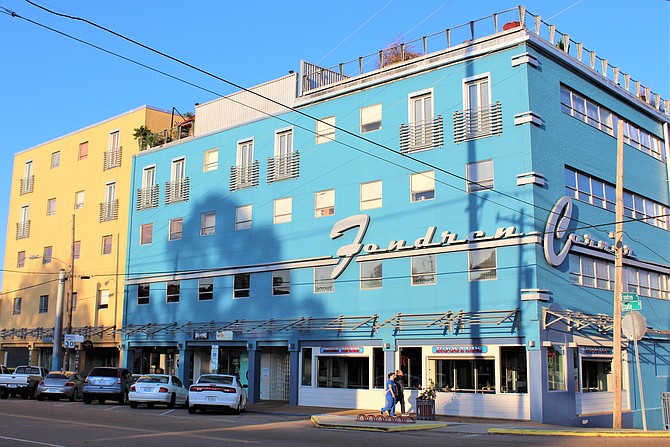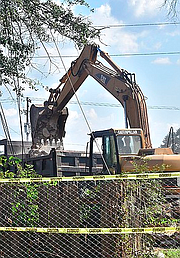Jackson's Fondren neighborhood is now officially one of the top 10 most endangered historic places in Mississippi. The designation comes in the midst of a Hilton hotel, and asbestos, controversy in the trendy neighborhood.
The trendy neighborhood that likes to bill itself as “Jackson’s hippest neighborhood” is now on the list of the “10 Most Endangered Historic Places in Mississippi.” Fondren joins a number of buildings and neighborhoods that are in dramatic stages of decay, from the abandoned Rodney in southwest Mississippi, to the Scott Ford Houses on Farish Street in Jackson, which once housed a slave woman and her daughter, a midwife.
Mississippi Heritage Trust announced its 11th list of the 10 most endangered historic places late today. The goal, the organization said in a statement, is to help protect and revitalize the historic places on the list.
Of Fondren, the Trust said: “Like many neighborhoods, Fondren suffered from urban decay in the 1980s. Through the dedicated work of local business leaders and residents, the area has grown and thrived in recent years. Full of local stores and restaurants, the bustling neighborhood has the largest concentration of modernist buildings in the state.”
Fondren Faces Controversial Hotel Boom
Hotels are piling into Jackson's trendy Fondren community—amid demolition and asbestos controversies.
Long-time Fondren businessman Ron Chane nominated the neighborhood, known as Jackson’s first suburb from the days that the city itself had a smaller footprint. Chane, a high-energy innovator, has long had a retail presence in Fondren and was a vital part of the area’s revitalization into a trendy neighborhood that is now attracting large development, some of it controversial.
“I nominated Fondren to be on the most endangered list because I would like to see its character and integrity preserved for the future,” Chane told the Jackson Free Press. “Fondren is a happy community that is what it is because of what it is not.”
Too Late for the ‘Fondren House’
The timing of the designation is auspicious as the neighborhood just watched two acres in the heart of the business district be demolished to clear land for a large Hilton Homewood Suites hotel. Many neighbors were against the project, which had been rumored for at least a year and a half, but developers would not provide details to residents unless they signed a non-disclosure agreement, many of them say.
On Sept. 19, 2017, Fondrenites gathered to question developers of the project, including investor and the original land owner, Alan Lange, who lives in a residential part of Fondren. Part of their concerns focused on what would happen to the “Fondren House,” which once housed the family the neighborhood drew its current name from. (The area was originally called “Asylum Heights” due to its proximity to the old “insane asylum” on the site of what is now the University of Mississippi Medical Center.)
The Fondren House, also called the “Yellow House,” was a Colonial Revival structure at 2819 North State St., until bulldozers showed up suddenly two days after the community meeting to destroy it. It is registered on an application to the National Register of Historic Places as dating back to 1905, although some residents believed it might have been built as late as the 1920s.
It also did not please neighbors that the initial structures on the site were demolished without adequate asbestos detection abatement until the buildings lay in shambles. At that point, calls to the Mississippi Department of Environmental Quality drew inspectors to the hotel site, who found asbestos, although the developers of the hotel, Fondren Hospitality LLC., had filed a report with the city saying a private inspector had found none of the toxic material. MDEQ ordered the developers to halt demolition until asbestos could be abated, documents MDEQ released to the Jackson Free Press showed this week. The documents also indicate that required demolition documents were not filed with MDEQ or the city until after the initial demolition and discovery of asbestos.
After the asbestos was cleared, the demolition restarted with the building that once housed Que Sera Sera restaurant and more recently Green Ghost Tacos destroyed on Oct. 3.
Reached that day via email, hotel investor Lange indicated that everything was on schedule and clean of asbestos, not confirming or denying rumors that the site was temporarily shut down for environmental testing after Heffner called MDEQ.
"The demolition is fully operational and on schedule," Lange wrote in an email to the Jackson Free Press on Oct. 3. "The Green Ghost building came down today."
Photo Gallery
Demolition for Fondren Hilton Homewood Suites Hotel
Demolition of a 2-acre plot in the heart of Fondren to clear ground for a Hilton Homewood Suites hotel started Sept. 21, 2017. Here are before-and-after images of the land.
“Today, there are concerns that Fondren will fall victim to its own success, as historic buildings are demolished to make way for large-scale developments,” the Mississippi Heritage Trust said in the statement today. “Neighbors have rallied to demand a local historic district designation for Fondren, which would allow for community input on future projects.”
Chane said today that he hopes the new designation will preserve what is best about Fondren for future generations. “Hopefully, this ‘endangered’ status will prevent future threats to the character and integrity of a great district tilled by creative and build by dreamers,” he told the Jackson Free Press.
‘Tremendous Victories’
The Mississippi Heritage Trust said it has seen “tremendous victories” since it first published the endangered list in 1999, including the King Edward Hotel in downtown Jackson, which sat as a dilapidated eyesore on downtown until HRI Lodging out of New Orleans worked with local attorney/developer David Watkins, former New Orleans Saints running back and Mississippi native Mississippi Deuce McAllister and others to renovate the old King Edward into a Hilton Garden Inn Hotel, which opened in 2009.
“The Cutrer Mansion in Clarksdale, the King Edward Hotel in Jackson, the L.Q.C. Lamar House in Oxford, the Mary C. O’Keefe Cultural Center in Ocean Springs and the Tippah County Jail in Ripley are all ‘graduates’ of the list, providing inspiring examples of what can happen when communities come together with a spirit of cooperation and a vision for the future,” the Trust said in its statement today.
Constructed in the 1890s, the Scott Ford Houses are Jackson’s other location included on this year’s endangered list. Former slave Mary Green Scott and her daughter, mid-wife Virginia Scott Ford, once lived in the two small bungalows.
“Today, the houses sit amongst the blighted properties and vacant lots that characterize the once vibrant Farish Street neighborhood,” the Trust said. “Owned by the Scott Ford Houses Board of Trustees, the organization is working to restore the buildings as a museum complex to tell the story of midwifery and African American middle-class life in Jackson, but the organization has struggled to raise funding.”
The other eight entries on the new list are:
• Town of Rodney
“A bustling river port before the Civil Way, Rodney was largely abandoned when the Mississippi River changed course in the 1870s. The town is now a popular stop for intrepet tourists, but few of Rodney’s historic buildings remain. A brick store was recently deemed structurally unsound and demolished. Due to recurring flooding and vandalism, the Historic Natchez Foundation is exploring the possibility of moving the Rodney Baptist Church outside of town to higher ground. The Rodney Presbyterian Church, listed as endangered in 2003, faces an uncertain future as the exterior brick walls crumble. Soon, little will be left of the town that nearly became the capitol of the territory of Mississippi.”
• Stage Marye-Gillette House, Greenwood
“The Stage Marye-Gillette House, built to resemble a showboat, was once one of the most beautiful homes in Greenwood. Constructed in 1910, the Colonial Revival-style house stands out with its ornate wrap-around porch, central gabled dormer with a Palladian window and dentil cornice flanked by two small gabled dormers with Ionic pilasters and bas relief ornament in the gable ends. Today, the house sits empty and deteriorating, with its stunningly detailed porch a shambles. Currently for sale for $65,000, there is community interest in saving the house to become an inn and event space.”
• Cochran Hotel, Ackerman
“Constructed in 1908, the Cochran Hotel, also known as the Pinnix Hotel, replaced an older wooden hotel that was lost to fire. This fine brick building, with its welcoming wrap-around porch, is an excellent example of a turn-of-the-century railroad hotel. Citing structural issues, the owner has applied to have the building de-listed as a Mississippi Landmark in order to demolish it. The Mississippi Department of Archives and History has requested that the owner provide a Structural Condition Analysis before any action is taken. Residents of Ackerman have expressed interest in seeing this local treasure restored to become an inn to compliment the many heritage tourism attractions in the area. The building is currently for sale for $15,000.”
• Temple B'nai Israel, Natchez
“Completed in 1905, Temple B’nai Israel is remarkable for its signature dome, stained glass windows and ark of Italian marble. Built to seat 350 worshipers, the synagogue currently hosts regular services for groups of ten or fewer. While the remaining members continue to open the historic space for cultural events and celebrations, maintenance of the historic structure has become an increasingly difficult burden for the small congregation. Now owned by the Institute of Southern Jewish Life, the community is working to identify a new use for the temple that will ensure its future preservation.”
• The Walter Place, Holly Springs
“Built in 1859 for Harvey W. Walter by Holly Springs architect and contractor Spires Boiling, the Walter Place is a grand Greek Revival mansion framed by two Gothic towers. During the Union Army’s occupation of Holly Springs, General Grant’s family resided in Walter Place. The mansion was remodeled in 1903 by St. Louis-based architect Theodore C. Link, who was in Mississippi overseeing construction of the State Capitol in Jackson. Currently vacant, the building is suffering from the ravages of time. Located in the heart of Holly Springs, the Walter Place and five surrounding acres are for sale for $649,000.”
• New Hope Missionary Baptist Church, Estill
“New Hope Missionary Baptist Church is a rare example of an early twentieth century rural African American Delta church. Constructed in 1918, the building survived the great flood of 1927 because of its close proximity to Deer Creek, which is higher than the surrounding land. A wood-framed building with hints of Gothic Revival style in the infilled pointed arches, the abandoned church has several large holes in the roof, allowing rain to poor in. In addition to the leaking roof, there are cracks between much of the clapboard siding, allowing water to blow in during a storm.”
• Saragossa, Natchez
“An outstanding example of an early vernacular residence, Saragossa began life as an overseer’s house on the plantation owned by Stephen Duncan, who would become one of the largest slaveholders and cotton planters in the United States. Though the date of construction is unknown, an 1826 survey map depicts the house, then a side-gabled cottage with end chimneys, and eight slave quarters to the rear. Subsequent remodeling in the 1830s and 1850s enlarged the house and gave it the distinctive West Indies form it has today. Despite decades of neglect by an absentee owner, the house retains much of its historic character.”
• Mississippi’s National Heritage Areas, Gulf Coast, Delta and Hills
“Designated by Congress, National Heritage Areas like the Gulf Coast, Delta and Hills are a combination of natural, cultural, historic and recreational resources that have shaped a distinctive landscape. Community resources within a National Heritage Area benefit from a extensive partnership that supports heritage tourism efforts through collaborative planning, promotion and grant opportunities. The 2018 Federal Budget calls for the elimination of funding for this highly successful program, citing that the National Heritage Areas are “secondary to the primary mission of the National Park Service and would be better sustained with local funding.” The loss of federal support for Mississippi’s three National Heritage Areas would be a tremendous set-back to the many community partners who work tirelessly to develop Mississippi’s cultural assets to their fullest potential.”
Learn more at www.mississippiheritage.com and www.ms10most.com. Read more about planned Fondren hotels at jfp.ms/fondrenhotels. William Kelly III contributed reporting to this story.
More stories by this author
- EDITOR'S NOTE: 19 Years of Love, Hope, Miss S, Dr. S and Never, Ever Giving Up
- EDITOR'S NOTE: Systemic Racism Created Jackson’s Violence; More Policing Cannot Stop It
- Rest in Peace, Ronni Mott: Your Journalism Saved Lives. This I Know.
- EDITOR'S NOTE: Rest Well, Gov. Winter. We Will Keep Your Fire Burning.
- EDITOR'S NOTE: Truth and Journalism on the Front Lines of COVID-19





